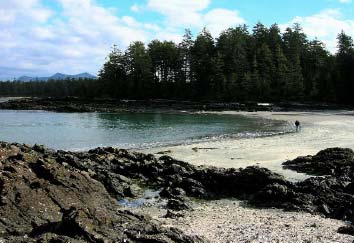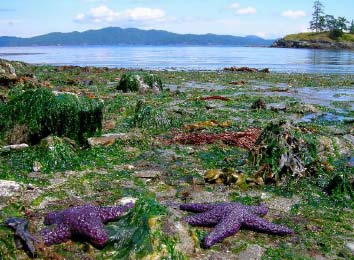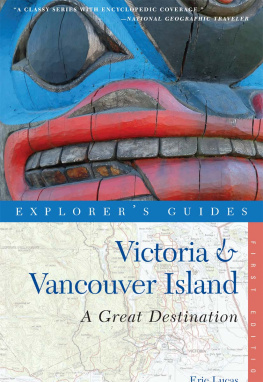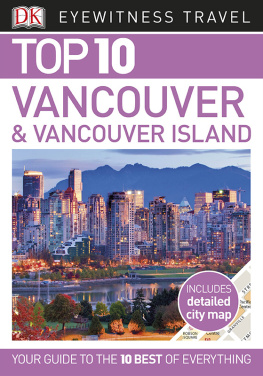EXPLORERS GUIDES
V ICTORIA & V ANCOUVER I SLAND

Capital building in Victoria. iStockphoto/Ekins Designs
EXPLORERS GUIDES
FIRST EDITION
V ICTORIA & V ANCOUVER I SLAND
A GREAT DESTINATION
Eric Lucas

Copyright 2011 by Eric Lucas
All rights reserved. No part of this book may be reproduced in any form or by any electronic or mechanical means, including information storage and retrieval systems, without permission in writing from the publisher, except by a reviewer, who may quote brief passages.
Explorers Guide Victoria & Vancouver Island: A Great Destination
978-1-58157-128-8
Interior photographs by the author unless otherwise specified
Maps by Erin Greb Cartography, The Countryman Press
Published by The Countryman Press, P.O. Box 748, Woodstock, VT 05091
This book is dedicated to all the wonderful people of Canada,
from the First Nations bands who have worked hard
to preserve and protect their rich traditions;
to all the immigrants since who have built one of the planets
most diverse and most welcoming countries.
Canada is truly a special place.


Nordic skiing, Mount Washington
A N I NTRODUCTION TO V ANCOUVER I SLAND
At one end of Vancouver Island, in Victoria, tall palm trees stand watch over a flower-bedecked harbor promenade with a distinctly Mediterranean air. In the background a world-famed Edwardian hotel offers high tea to international guests clinking bone china and sterling silver beneath crystal chandeliers.
At the other end of the island, 280 miles north-northwest, wilderness hikers stroll a 1-mile (1.6 km) crescent of ivory beach at Cape Scott, checking for wolf and bear tracks. Ancient cedar and spruce trees lean over storm-tossed dunes and drift logs, bald eagles call from nearby headlands, and seals and sea lions prowl the bay.
These two extremes typify Vancouver Island. Few places on earth offer as much cultural, climatic and geographic diversity as this 12,076-square-mile (19,434-square-km) bastion on the west coast of Canada. The southeast corner of the island is one apex of a triangle of civilization whose other points are Seattle and Vancouver; and in some regards Victoria, an erstwhile colonial capital of the British Empire, is the most civilized of the three. Few other places on earth still offer high tea as a daily tradition in elegant colonial surroundings.
Yet not far away, in a remote wilderness valley, stands one of earths largest trees, a 312-foot (95 m) Sitka spruce thats emblematic of a maritime rainforest saved from logging by late 20th-century environmental activism. And a denizen of that rainforest, a cougar, once turned up in the Empress Hotels parking garage in Victoria. (It was expeditiously trapped and returned to the forest, and all involved repaired upstairs for tea.)
Long inhabited by aboriginal peoplesat least as long as 10,000, and perhaps 30,000, yearsthe islands natural treasures have always been its draw. First Nations peoples thrived on salmon, shellfish, and berries. European settlers were drawn in the early 1800s by fish and timber, and fortunes were built on those two resources, plus coal. Trade and government became economic staples as gold rushes spurred booms in British Columbias interior. Today, more than 1 million annual visitors come to experience the islands beauty and diversity.
Heading north from Victoria, in the Cowichan Valley, tidy vineyards supply a growing winery district in which visitors can enjoy a breathtaking wealth of locally grown sustainable foods. An hour onward, at Parksville, vacationing families gather on sun-warmed sand whose waters are as mild as milk.
Another hour to the north is a family-friendly homegrown ski resort that often collects the greatest seasonal snow accumulation in North America. Yet late spring visitors to the Comox Valley below Mount Washington can golf in the afternoon following a half-day of skiing in the morning.
North of there, two hours and a ferry ride worth, is a tiny island with a world-class museum in which visitors can see stunning aboriginal art with a most memorable backstorystolen from its First Nations owners a century ago, it has been returned to its home and lovingly displayed.
Just northeast of Victoria are a half-dozen delightfully scenic, friendly, and low-key smaller islands perfect for relaxed getaways. Meanwhile, out on the west coast of the island, Pacific swells roll into a long strand of beach at Tofino renowned as Canadas surfing mecca. Tour boats ply hundreds of miles of inlets and coves so visitors can watch whales and eagles, bears and otters, porpoises and spawning salmon.

Big Tree Trail, Meares Island
All these attributes make Vancouver Island a fabulous visitor destination from almost any perspective. Adventurers, families, cosmopolitan global wanderers, bargain-hunting backpacker students, gourmandsthere are innumerable attractions for each. Painting a picture of the island as a travel paradise is easy.
Yet travel paradise is a simplistic assessment of a place with far more breadth and depth. This is a complex natural and human community whose modern character reflects both its wealth and the ever-present potential for misuse.
Every modern achievementthe island is a world capital of the sustainability movement, particularly in agriculture and food preparationrests astride a more troubling story. For all its sustainability, intense logging continues, and clear-cuts march to the very edge of world-class ecological preserves. Factory fish farms pollute remote bays at the same time island chefs mount a global campaign to conserve ocean fisheries. Wildlife abounds, and the ever-growing industry devoted to bringing tourists out to see wild creatures subjects them to disturbance and sometimes outright torment.
Visitors thus have a chance to enjoy and learn, taste and honor, touch and value one of the worlds most precious places. This book is a guide to Vancouver Islands wonders with a discreet plea for its vulnerabilities; no one who loves it as I do can overlook either. When you respectfully savor its foods, swim its waters, scale its mountains, stroll its beaches, and admire its beauty, you are adding to this matchless wealth, and enriching your own life.

Vargas Island beach, Clayoquot Sound Leslie Forsberg

Star of the tide pools Leslie Forsberg
A BOUT T HIS G UIDE
This book was born in my love for Vancouver Island, which I often name as the answer to the question every travel writer faces incessantly: Whats your favorite place? Ive been all over the world, and I find myself longing for places in and around Vancouver Island as much as or more than anywhere else. Luckily, I live quite close.
Next page









